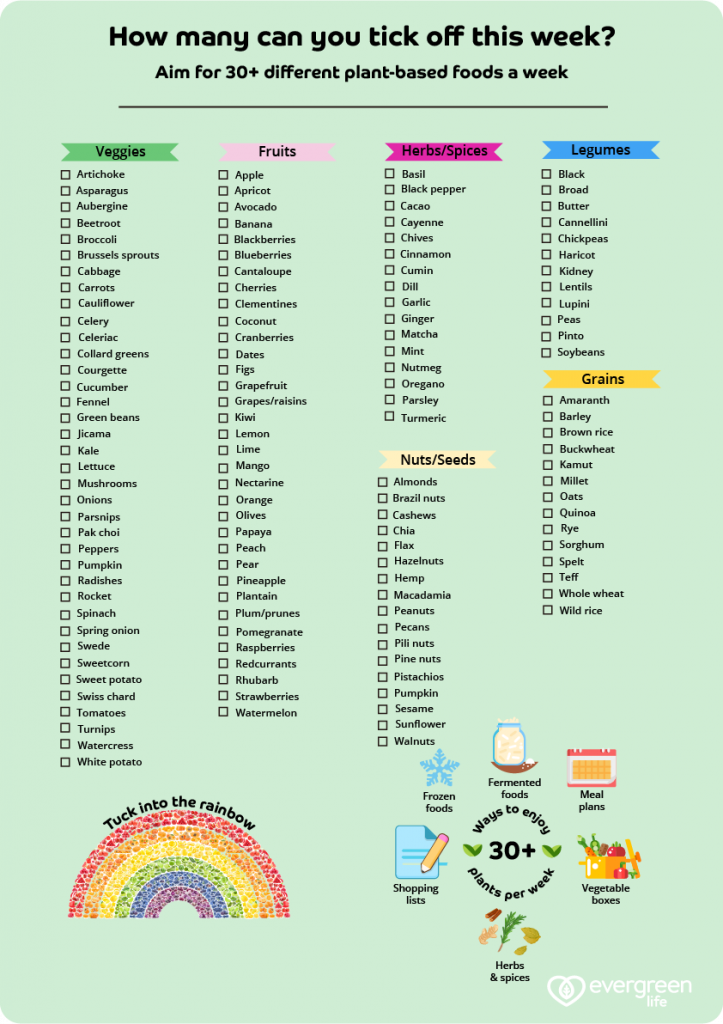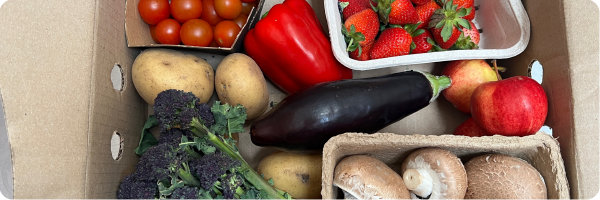In order to help our bodies function well, we need an abundance of nutrients. In fact, a 2017 analysis of 95 studies found that eating ten or more (800g) different vegetables and fruit daily has a myriad of health benefits, including being associated with a reduced risk of cardiovascular disease, cancer and all-cause mortality. Sometimes referred to as ‘nature’s pharmacy’, eating 30+ different plant foods each week can do wonders for your gut health. Each vegetable brings a different combination of nutrients that can help the body. For example, kale can improve collagen and elastin levels for better skin health.

Bursting with natural anti-inflammatory and antioxidant chemicals or compounds called phytonutrients (sometimes known as phytochemicals) as well as flavour, veggies can help protect us from viruses and the green leafy and cruciferous types in particular have been associated with sustained brain function in later life. Increasing vegetable intake, together with fruit, has even been proposed as an effective way of preventing asthma-related illness in children.
Indeed, vegetables are such nutritional powerhouses that the leading professional body for Registered Nutritional Therapy Practitioners, the British Association for Nutrition and Lifestyle Medicine (BANT), recommend we munch our way through at least seven different nourishing veg and fruit a day, advising that at least five of those come from veggies and fruit is limited to one-two portions a day.

With veggies being such an integral part of a healthy diet, how do you make sure you eat a rainbow of vegetables each day?
Start your day with veggies
Rather than reaching for processed and sugary cereals, add some watercress, broccoli, avocado and spinach to your breakfast as they can go well with eggs. Avocado is a great source of unsaturated fat, whilst eggs, which can also be an important source of fat, pack a protein punch.

“Omelette breakfast muffins are a hit with my four-year-old – I prep the batter (just eggs and milk) and bake them on a Sunday, filling it with veggies like peppers, carrots, peas, sweetcorn, broccoli and spinach, sprinkling in some chia seeds. Then I simply store them in an airtight container in the fridge, so they’re ready to pop in pack lunches during the week.”
– Evergreen Life Clinical Content Lead Claire
Mix yourself a smoothie
Quick and convenient, both veg and fruit can be added to a smoothie – though a good ratio is five veg and one-two pieces of fruit per drink. Dark green leady veg like spinach, kale and watercress, for instance, are rich in nutrients so you may wish to trial those. Adding lemon juice works well. If you’re after a sweeter taste, you can drizzle in some raw, organic honey or sprinkle in some frozen berries (though watch out for blueberries as they can really thicken the mixture!).
When adding liquid, water, or almond milk (check out Plenish, who use only organic ingredients and avoid flavourings, preservatives and additives) are wise choices rather than fruit juices, such as apple juice, which are full of sugar.
Why not browse some recipes online for inspiration then see how imaginative your smoothies could get?
Take a salad jar to work
If you’re time poor, salad jars can be a great option. The key lies in making sure you have the ingredients you need and then it’s just about assembling. Grab a mason jar (a glass jar with a screw on metal lid or, for a more eco-friendly and cost-effective option, re-use an old jam jar) and get layering those crispy and colourful veggies. You may wish to consider this recipe to kickstart your salad jar journey.
“I have run corporate wellbeing programmes for thousands of people and these salad jars always go down well. The key is to set aside time to prep (chop veg!) and batch cook (anything that needs cooking e.g., broccoli, green beans). For example, take an hour out on a Sunday for the first half of the week and then do same again on a Wednesday evening for the remaining days. The more it becomes a habit the easier it is to sustain, and you can get really creative – I love making mine as colourful as possible!”
– Former Evergreen Life Head of Content and Wellness Expert, Anna

Get your roast on
Don’t fancy yourself a cook? One easy way to eat more vegetables is to roast delectable array of them. Simple as that. No fancy cooking skills needed. Pop on some music while you chop and prep the veg and away you go. This roasted vegetables recipe is ideal to get you going, plus roasted veg make mouth-watering kebabs.
It’s worth noting that different methods of cooking can have a variety of impacts on the nutritional content of a range of veg. For instance, high heat or lengthy cooking can destroy some of the vitamin C content in food. So, you may like to have sources of vitamin C like bell peppers, kale, and tomatoes, raw in salads too.
However, goitrogenic compounds found in cruciferous veggies like cauliflower, cabbage and swede reduce the use of the important nutrient, iodine in the body. They may also disrupt the usual function of the thyroid gland if eaten in large quantities. Fortunately, cooking these cruciferous veggies seems to destroy many of the goitrogenic compounds they contain.
Embrace soups
Warming soups are another vibrant way to veg galore and make great lunches. This appetising collection of vegetable soup recipes should serve up some inspiration. Challenge yourself to make a huge batch of soup and see how many different veggies you can blend in; could you get to 30?! There’s no need to thaw soup before re-heating and you can use frozen veg too.
Another suggestion is to freeze your soup into ice cubes, which you can then toss into your smoothies to boost your vegetable intake.
Try a veggie box

If supermarkets aren’t for you, a veggie box is a great way of making sure you pack in those necessary nutrients each day by delivering them right to your door. Available from different companies, they’re an ideal opportunity to opt for organic and sustainable produce that demand less packaging and fewer food miles.

“I really look forward to my colourful veggie box arriving each week. I can tailor it to my tastes and get exposed to varieties of veg I can’t access in supermarkets and wouldn’t usually consider.“
– Evergreen Life Content Manager, Roisin
Get creative with veggie ice pops / lollies
Yes, you read that heading right. Perfect for summer, these refreshing rainbow snacks appeal to kids and can feature any fruit and veg providing you can blend it into a puree that can freeze. This means you can experiment and find your favourite fun flavours. All you need is a blender or hand blender, ice pop pouches, or lolly sticks or moulds.
Cut ‘em small and pack ‘em big
Weaving a scrumptious assortment of veggies into your meals can bulk them out, filling you up on the good stuff. Cutting them up small can make them less noticeable for family members that aren’t veg fans. Stews, chilli con carnes, spag bol and stir fries are great dishes to do this with.
Where you can, opt for organic veggies that haven’t been treated with synthetic fertilisers and chemical pesticides, which can disrupt your gut microbiome. UK charity, Pesticide Action Network (PAN) analyses government data and has created a “Dirty Dozen” list of produce that have recorded the highest levels of pesticides residue, so you know where to focus your efforts when buying organic.
If you’re unable to always buy organic food, why not try and incorporating some of the tasty foods that the Environmental Working Group cite as boasting less pesticide residue levels compared to other veg and fruit into your meals?
“I’m a big fan of loading one-pot dishes with veg. You can’t beat homecooked food as you know what’s gone into it. I love tangy sweet and sour stuffed with celery, red pepper and onion, broccoli, carrot and bean sprouts for a diverse texture.”
– Evergreen Life Content Writer, Jayna

We hope these sparked ideas on how you can eat more veg. To support your nutritional health beyond getting your veg fix, visit the Food section in the Evergreen Life app.
Reviewed by:
Anna Keeble MA BA Wellbeing Expert
Dr Claire Marie Thomas MRCGP DFSRH DTMH DipNLP MBChB BMedSci Medical Expert
- Agnes (2019) Easy Rainbow Fruit and Veggie Ice Pops. Hello, Wonderful.
- Aune D, Giovannucci E, Boffetta P, et al. (2017) Fruit and vegetable intake and the risk of cardiovascular disease, total cancer and all-cause mortality—a systematic review and dose-response meta-analysis of prospective studies. International Journal of Epidemiology, 46: 1029–1056 (doi: 10.1093/ije/dyw319).
- BBC Good Food (n.d.) Vegetable soup recipes. BBC Good Food.
- Better Health (n.d.) Chilli con carne recipe. NHS.
- Better Health (n.d.) Spaghetti Bolognese recipe. NHS.
- British Association for Nutrition and Lifestyle Medicine (BANT) (2021) Count colours, not calories More Variety = More Phytonutrients. British Association for Nutrition and Lifestyle Medicine.
- Chiu K, Warner G, Nowak RA, et al. (2020) The Impact of Environmental Chemicals on the Gut Microbiome. Toxicological Sciences 176 : 253–284 (doi: 10.1093/toxsci/kfaa065).
- Dady J (2022) Vegetable stew recipe. GoodtoKnow.
- Environmental Working Group (EWG) Science Team (2023) EWG’s 2023 Shopper’s Guide to Pesticides in Produce. Environmental Working Group (EWG).
- Fam VW, Charoenwoodhipong P, Sivamani RK, et al. (2022) Plant-based Foods for Skin Health: A Narrative Review. Journal of the Academy of Nutrition and Dietetics 122: 641-629 (doi: 10.1016/j.jand.2021.10.024).
- Fox H (2023) How to Pack a Salad in a Jar + 21 Stunning Recipes. HurryTheFoodUp.
- Grimes L (n.d.) Simple stir-fry. BBC Good Food.
- Harvard T.H. Chan School of Public Health (2023) Vitamin C. Harvard T.H. Chan School of Public Health.
- Hosseini B, Berthon BS, Jensen ME, et al. (2022) The Effects of Increasing Fruit and Vegetable Intake in Children with Asthma on the Modulation of Innate Immune Responses. Nutrients 14: 3087 (doi: 10.3390/nu14153087).
- Hsu A (2021) How to Make Fruit and Vegetable Popsicles. Hello, Yummy.
- Martha Stewart Test Kitchen (2019) Everyday Vegetable Soup. Martha Stewart.
- Monjotin N, Amiot MJ, Fleurentin J, et al. (2022) Clinical Evidence of the Benefits of Phytonutrients in Human Healthcare. Nutrients. 14: 1712 (doi: 10.3390/nu14091712).
- Oliver J (n.d.) Roasted vegetables. Jamie Oliver.
- Pesticide Action Network UK (n.d.) The Dirty Dozen. Pesticide Action Network UK.
- Ramsey-Haskell and Docherty S (2023) Role of fruit and vegetables in sustaining health cognitive function: evidence and issues. Proceedings of the Nutrition Society: 1-10 (doi: 10.1017/S0029665123002999).
- Rogerson D (2017) Vegan diets: practical advice for athletes and exercisers. Journal of the International Society of Sports Nutrition 14: 36 (doi: 10.1186/s12970-017-0192-9).





